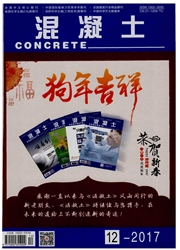

 中文摘要:
中文摘要:
针对目前混凝土结构温控仿真及评价中存在缺乏考虑早龄期拉伸徐变的问题,建立了考虑多因素影响的拉伸徐变系数预测通式,开发了考虑拉伸徐变效应的混凝土温控仿真程序。利用拉伸徐变试验成果,对代表性的徐变系数预测模型,即CEBFIP90模型、ACI模型及双幂模型进行了参数识别、规律分析及模型修正后,用于混凝土早龄期拉伸徐变的预测与仿真。通过有限元算例,分析拉伸徐变对早龄期混凝土表面应力场的影响,结果表明拉伸徐变能有效减小早龄期混凝土表面拉应力值和改善表面应力场分布,对温控防裂有利。
 英文摘要:
英文摘要:
Aiming at the problem of no tensile creep in simulation and evaluation of temperature control of concrete structure, the basic function of tensile creep coefficient was built by means of trend analysis of concrete creep.Based on tensile creep end restraint experi- ment of a ratio concrete, the creep coefficient classical prediction model, namely CEB - FIP90 model, ACI model and the double expo- nential model was fitted, and the regularity was analyzed, and then the double exponential model was modified to improve its fitting effect.The results show that after proper correction, compression creep model can be used to predict concrete tensile creep at early age. Using temperature control program with tensile creep and FEM case, the effect of tensile creep in surface stress field is analyzed at early age. The result has been proved that concrete tensile creep can reduce the surface tension value and improve the surface stress distribu- tion, which is favorable for temperature control and crack prevention.
 同期刊论文项目
同期刊论文项目
 同项目期刊论文
同项目期刊论文
 期刊信息
期刊信息
